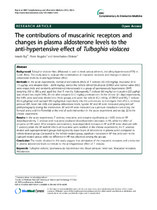| dc.contributor.author | Raji, Ismaila A. | |
| dc.contributor.author | Mugabo, Pierre | |
| dc.contributor.author | Obikeze, Kenechukwu | |
| dc.date.accessioned | 2013-05-06T12:52:39Z | |
| dc.date.available | 2013-05-06T12:52:39Z | |
| dc.date.issued | 2013 | |
| dc.identifier.citation | Raji, I. et al. 2013. The contributions of muscarinic receptors and changes in plasma aldosterone levels to the anti-hypertensive effect of Tulbaghia violacea. BMC Complementary and Alternative Medicine. 13(13): 1-11 | en_US |
| dc.identifier.issn | 1472-6882 | |
| dc.identifier.uri | http://hdl.handle.net/10566/600 | |
| dc.identifier.uri | http://dx.doi.org/10.1186/1472-6882-13-13 | |
| dc.description.abstract | Background: Tulbaghia violacea Harv. (Alliaceae) is used to treat various ailments, including hypertension (HTN) in
South Africa. This study aims to evaluate the contributions of muscarinic receptors and changes in plasma
aldosterone levels to its anti-hypertensive effect.
Methods: In the acute experiments, methanol leaf extracts (MLE) of T. violacea (30–120 mg/kg), muscarine (0.16
-10 μg/kg), and atropine (0.02 - 20.48 mg/kg), and/or the vehicle (dimethylsulfoxide (DMSO) and normal saline (NS))
were respectively and randomly administered intravenously in a group of spontaneously hypertensive (SHR)
weighing 300 to 350 g and aged less than 5 months. Subsequently, T. violacea (60 mg/kg) or muscarine (2.5 μg/kg)
was infused into eight SHRs, 20 min after atropine (5.12 mg/kg) pre-treatment. In the chronic (21 days) experiments,
the SHRs were randomly divided into three groups, and given the vehicle (0.2 ml/day of DMSO and NS), T. violacea
(60 mg/kg/day) and captopril (10 mg/kg/day) respectively into the peritoneum, to investigate their effects on blood
pressure (BP), heart rate (HR), and plasma aldosterone levels. Systolic BP and HR were measured using tail-cuff
plethysmography during the intervention. BP and HR were measured via a pressure transducer connecting the
femoral artery and the Powerlab at the end of each intervention in the acute experiment; and on day 22 in the
chronic experiment.
Results: In the acute experiments, T. violacea, muscarine, and atropine significantly (p < 0.05) reduced BP
dose-dependently. T. violacea and muscarine produced dose-dependent decreases in HR, while the effect of
atropine on HR varied. After atropine pre-treatment, dose-dependent increases in BP and HR were observed with
T. violacea; while the BP and HR effects of muscarine were nullified. In the chronic experiments, the T. violaceatreated
and captropril-treated groups had signicantly lower levels of aldosterone in plasma when compared to
vehicle-treated group. Compared to the vehicle-treated group, significant reduction in BP was only seen in the
captopril-treated group; while no difference in HR was observed among the groups.
Conclusion: The results obtained in this study suggest that stimulation of the muscarinic receptors and a reduction
in plasma aldosterone levels contribute to the anti-hypertesive effect of T. violacea. | en_US |
| dc.language.iso | en | en_US |
| dc.publisher | BioMed Central | en_US |
| dc.rights | © 2013 Raji et al.; licensee BioMed Central Ltd. This is an Open Access article distributed under the terms of the Creative
Commons Attribution License (http://creativecommons.org/licenses/by/2.0), which permits unrestricted use, distribution, and
reproduction in any medium, provided the original work is properly cited. | |
| dc.subject | Tulbaghia violacea | en_US |
| dc.subject | Spontaneously hypertensive rats | en_US |
| dc.subject | Blood pressure | en_US |
| dc.subject | Heart rate | en_US |
| dc.subject | Muscarinic receptors | en_US |
| dc.subject | Aldosterone | en_US |
| dc.title | The contributions of muscarinic receptors and changes in plasma aldosterone levels to the anti-hypertensive effect of Tulbaghia violacea | en_US |
| dc.type | Article | en_US |
| dc.privacy.showsubmitter | FALSE | |
| dc.status.ispeerreviewed | TRUE | |
| dc.description.accreditation | ISI | en_US |

